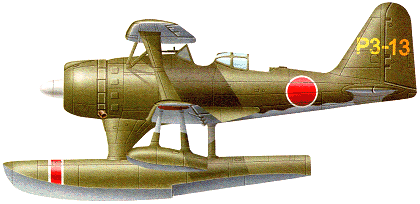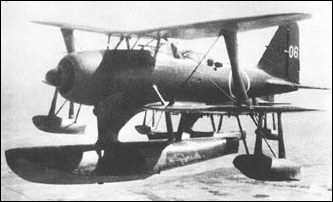|
| Roughly equivalent to the American
Curtiss SOC Seagull observation float
biplane, the smaller Mitsubishi F1M
was of more compact and neater design,
its development starting about
two years later in 1934. First flown in
June 1936, the F1M1 embodied all the
efforts of its designers to achieve an
exceptionally clean aerodynamic
shape, including low-drag float mountings,
single interplane struts and all-metal
construction, only the control
surfaces being fabric-covered. The
early aircraft displayed poor water
handling and a lack of in-flight directional
stability, however, but after fairly
extensive alterations the production
F1M2 emerged as a thoroughly
efficient aircraft, acceptable in all respects.
Initial production by Mitsubishi,
which got under way in 1938,
amounted to 524 aircraft before it was
transferred to the 21st Naval Air Arsenal
(Dai-Nijuichi Kaigun Kokusho) at
Sasebo, where a further 590 were built.
In due course the F1M2 equipped all
but one of the K-Maru (6,900-ton) and
S-Maru (7,200/8,300-ton) classes of
converted merchant seaplane tenders,
as well as numerous battleships
and cruisers of the Imperial Japanese
Navy. Codenamed 'Pete' by the Allies,
FlM2s were present at the Battle of
Midway, two aircraft being launched
from the battleship Kirishima (but
being lost when the Japanese scuttled
the sorely-crippled ship at the end of
the Battle of the Solomons). The giant
superbattleships Musashi and Yamato
each carried several 'Petes' to spot for
their 460mm main gun armament
at the time of the Marianas battles,
but none was used in earnest; instead
the Musashi succumbed to
American bombs and torpedoes in the
Sibuyan Sea; the Yamato, bent on a
suicide mission to Okinawa, followed
her to the bottom on 7 April 1945.
Nevertheless 'Pete' seaplanes were
widely used throughout the Pacific
war, accompanying every seaborne
landing by Japanese forces, providing
gunnery spotting during preliminary
bombardment by supporting warships
and subsequently serving as covering
fighters (and even dive-bombers)
once the assault forces were ashore. It
was also flown on convoy escort duties
with the many supply convoys sailed
by the Japanese during the mid-war
period. In the last stages of the war, the
type was committed to the unequal
task of defending the Japanese homeland
from the devastating American
raids, serving alongside 'Rex' and
'Rufe' seaplane fighters with the Otsu
Kokutai in 1945.

| MODEL | F1M2 |
| CREW | 2 |
| ENGINE | 1 x Mitsubishi "Tsuisei-13", 655kW |
| WEIGHTS |
| Take-off weight | 2550 kg | 5622 lb |
| Empty weight | 1928 kg | 4251 lb |
| DIMENSIONS |
| Wingspan | 11 m | 36 ft 1 in |
| Length | 9.5 m | 31 ft 2 in |
| Height | 4 m | 13 ft 1 in |
| Wing area | 29.54 m2 | 317.97 sq ft |
| PERFORMANCE |
| Max. speed | 365 km/h | 227 mph |
| Ceiling | 9440 m | 30950 ft |
| Range | 730 km | 454 miles |
| ARMAMENT | 3 x 7.7mm machine-guns, 120kg of bombs |
 | A three-view drawing (752 x 1231) |
| Hiram, e-mail, 06.01.2024 02:07 We would like to thank you once more for the lovely ideas you offered Janet when preparing her post-graduate research plus, most importantly, regarding providing all
the ideas in a blog post. Provided we had known of your website a year ago, we might have been saved the unwanted measures we were selecting.
Thanks to you. toys for adults reply | | L. B. Dorny, e-mail, 25.09.2014 11:26 Among others, F1M2s equipped the floatplane units in seaplane carriers Chitose and Mizuho during the East Indies Campaign through March 1942, providing both anti-air and anti-submarine defense for invasion convoys to Menado /Kema, Kendari, Ambon, and Timor. Over Kema, Celebes, on 11 Jan. they turned back seven PBY Catalinas in a level bombing formation, shooting down one Dutch and one USN PBY. reply | | Patrick, e-mail, 13.04.2014 06:41 the Japanese stuff has some special mystique imo.
These things (as opposed to the Rufe float-zero) actually fought dogfights in the Solomons with US P39s...the P39 was so bad that it was actually a more even match than it might look on paper...not only the Japanese battleships, but the big cruisers in particular like Chokai, Mogami and Tone, would also have a mixed catapult group of up to 5 of these and the larger twin-flat "Jack" scouts. reply | | Sultan, e-mail, 05.04.2013 04:56 This aircraft Provided the Yamato with gunnary spotting and Guidance in the battle off Samar, it operated as a reporter for outcomes of Salvos. during this battle the first salvo fired by the yamato hit the USS white plains, she also sunk another vessel and heavily damaged two others. reply | |
| | Joe, e-mail, 12.03.2013 17:00 Citations please. reply | | Ken Robinson, e-mail, 29.01.2012 20:16 Submarine USS Grunion 216 July 30-31 1942 The Japanese Merchant ship Kano Maru took aboard a "Pete"( Mitsubishi F1M) who had ditched just off Kiska Alaska. 2 man crew was safe and plane was craned aboard. See Grunion web site. Ken reply | | Bob Shelley, e-mail, 09.11.2010 20:51 There are documents available through the Smithsonian showing all of the dimensions and individual parts of the Pete. Unfortunately there are fees... but you might be able to select the images you want. reply | | Jesper, e-mail, 22.03.2010 15:05 I am working on a R /C scale model in size 1:5 of this plane. It will be online here soon: www.natureandtech.com reply | | Mick, e-mail, 23.11.2008 04:22 One of my favourite Aircraft of all time! What a Warbird it would make!!! reply | | Mike Belue, e-mail, 07.09.2007 08:01 Could you please help me with some cockpit photos of this plane? I've been searching for a while and haven't found anything at all.
Thanks,
Mike reply |
|
Do you have any comments?
|
| 
COMPANY
PROFILE
All the World's Rotorcraft
|








